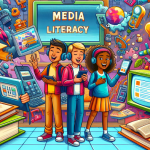
Media Literacy Digital Breakout

Overview
Media literacy is the ability to understand, analyze, and critically evaluate media messages. It involves recognizing bias, understanding purpose, and identifying target audiences in various forms of media.
During this activity, students will be asked to complete a digital breakout room built within a Google Site.
Learning Objectives
Students will:
Understand the difference between misinformation, disinformation, and malinformation.
Understand what Media refers to in context to online and offline resources and platforms.
Become familiar with how to determine if news is real or fake.
- Become familiar with how to check online resources.
Vocabulary
Vocabulary Words:
Fake News: Fake News is false or misleading content presented as news and communicated in formats spanning spoken, written, printed, electronic, and digital communication.
Misinformation: Misinformation is false, but not created or shared with the intention of causing harm.
Disinformation: Disinformation is deliberately created to mislead, harm, or manipulate a person, social group, organization, or country.
Malinformation: Malinformation is based on fact, but used out of context to mislead, harm, or manipulate. An example of malinformation is editing a video to remove important context to harm or mislead.
Currency: Currency, in terms of news, is the information that represents the current time and updated as needed.
Relevance: Relevance is how closely something connects to what we’re talking about or learning.
Authority: Authority, in terms of news, means that the person writing the information has the credentials and expertise in that content area.
Accuracy: Accuracy is how close something is to being correct.
Media Literacy: Media Literacy is being smart about and understanding messages in the media - like TV, video games, social media, photographs, and more.
Pre-planning
To prepare for this lesson:
- If this is the first digital breakout room for you and your students, you will want to watch this Digital Breakout Example from REMC’s 21Things4Students. This Breakout is created in a Google Site and uses an embedded Google from as the locks
- Teacher will need to check to make sure the Breakout and resources within the Google site are accessible on student devices.
- Teacher should complete the Media Literacy Breakout room as a student.
- Teacher will want to preview this video (Face vs. Fake: A Quick Lesson in Media Literacy by CBC Kids 1min 49sec) and use as an introduction to the Media Literacy Breakout room.
Accommodations
See Accommodations Page and Charts on the 21things4student website in the Teacher Resources.
Steps
Directions for this activity:
The teacher will want to make sure students understand what a Digital Breakout room is prior to starting the lesson.
Show this Digital Breakout Example from REMC’s 21Things4Students.
Preview the Media Literacy Breakout room with the class.
Let the students know that they will need to show the teacher the page that is displayed after they submit the form.
Teacher will want to determine what is granted for breaking out.
Teacher may want to provide a brief overview of what it means to raise a number to the power of a number for the Picture Puzzle clue. 5th grade math deals with powers of 10 but not in the context of squaring or cubing a number.
The teacher will want to provide an overview of Media Literacy.
Show this video (Face vs. Fake: A Quick Lesson in Media Literacy by CBC Kids 1min 49sec) as an introduction to the Media Literacy Breakout room.
Discuss forms of media that the students use in their lives.
It is recommended to use small groups or partners to complete this breakout. Assign those groups at this time.
Encourage collaboration within the group with friendly competition between groups so keeping your answers secret from other groups is important.
Remind students to celebrate once they breakout and show the teacher the final submission page from the form.
As a class, discuss the process of the breakout and the information learned about Media Literacy.
Assessment Options
Different options for assessing the students:
Observation while students are completing the breakout.
Asking questions to each group while they are working to check for understanding.
Evidence of final submission page from Google form.
MITECS COMPETENCIES & ISTE STANDARDS
MITECS: Michigan adopted the "ISTE Standards for Students" called MITECS (Michigan Integrated Technology Competencies for Students) in 2018.
3a. Knowledge Constructor: Evaluate the accuracy, perspective, credibility, and relevance of information, media, data or other resources.
Devices and Resources
Device: PC, Chromebook, Mac, iPad
Browser: Chrome, Safari, Firefox, Edge, ALL
App, Extension, or Add-on:
Websites: Media Literacy Digital Breakout Google Site
Video: Fact vs. Fake: A Quick Lesson in Media Literacy
Video: Digital Breakout Example
CONTENT AREA RESOURCES
Computer Science
Students are able to decode to figure out words in a phrase.
ELA
Students are able to use vocabulary in a complete sentence.
Students are able to rationalize the context of sentences to find a solution.
Math
Students will decode symbols to represent numbers and complete the arithmetic involved with those symbols.
Science
Students will analyze media for issues and claims that are either true or false.
Social Studies
Students will understand the importance of media creation and the impacts it has on our society.
Credits
This task card was created by Mrs. Randi Brown from Swan Valley Public Schools.
June 2024


